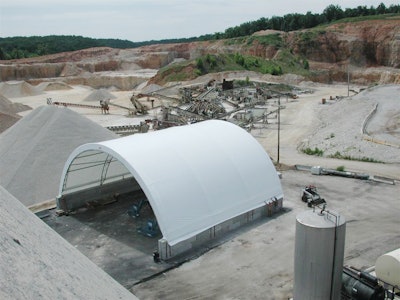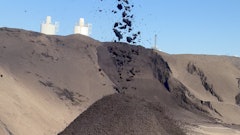
It’s a Monday morning, you’re headed to your construction aggregate plant after a weekend full of rain. That following Friday, all your stockpiles were covered in preparation for a wet Saturday and Sunday, but your nerves are still high. Negative scenarios are playing through your head, such as, what if the covers got blown-off resulting in the piles getting soaked?
You know the answer, but you don’t like what the outcome will be. It will increase your fuel costs and create extra time and labor in order to stay on track with your deadlines. However, there is a way to ease the mind of business owners. Keeping your aggregate piles sheltered in a fabric structure not only eliminates the possibility of the piles getting wet, but it also allows for peak plant productiveness.
Escaping the Problems of Wet Piles
Asphalt mixes are based on dry aggregate, so whenever there is moisture in the aggregate the mix must be adjusted to account for the moisture in the aggregate. Therefore, moisture management in aggregate piles is significant. Thankfully, fabric structures offer natural benefits to eliminate the possibility of coming in on Monday after a rainy weekend to soggy and contaminated piles.
Superior ventilation is a major benefit of fabric structures and helps maintain low moisture levels. A little bit of moisture is common in aggregate piles and is helpful to prevent materials from blowing around while being stored. Healthy ventilation prevents the chance for high humidity levels, and an increase in moisture buildup. For the best air-circulation owners can place the structure in the direction of the prevailing winds at their location. They also have the choice of an open or fully enclosed design. Some companies offer ridge vents and fans to provide adequate airflow if more is needed.
Contamination is a big problem that owners run into when piles are exposed to inclement weather. High winds and heavy rain naturally blow around contaminates, such as leaves, causing them to mix with the piles. Cross-contamination also happens frequently from bad weather moving oversized aggregate into finer aggregate piles or vice versa.
This can be avoided with these structures, because of their open-floor design. Owners can arrange the floor layout and use dividers to make sure there is appropriate distance between each pile of aggregate. Owners often opt for a one-sided design structure, so machinery can easily access each pile individually, since the structure can easily be divided into separate bays.
Choosing the correct foundation is also significant to moisture management. A popular option for aggregate storage is traditional poured concrete, because it doesn’t absorb moisture like the natural ground and eliminates the need for storage bins. Although this is a top foundation option an owner isn’t forced into this specific foundation; other foundation options are available, such as helical anchors, piers, shipping containers, among many others.
Lastly, business owners should look for a fabric structure that is covered with a durable fabric cover. The covers can be moisture-resistant and climate controlled. This cuts down on moisture buildup and creates a comfortable climate inside the structure in any climate. The best covers feature a weave design that helps resist tearing and exposing the piles to the outside weather, allowing them to withstand high winds, heavy rain and snow loads. A bonus is during daylight hours, the covers let in natural light cutting artificial lighting costs.
Enjoy a More Productive Workday
When workers come into wet piles, instead of getting right to work on deliveries, workers must spend time going through the piles to see which have the least amount of moisture and can be used immediately. This causes a slower process, because more moisture in the piles means more time needed during the drying process, forcing a stall in the operation.
Having dry aggregate to work with every day increases production levels and is less of a financial burden. It leads to less fuel needed during the drying process and shortens the time needed for proper aggregate production. The drier the aggregate is, the smoother the overall drying process will go.
Moisture management is a major issue, but reducing aggregate moisture by one percent before drying can reduce energy use upwards of 11 percent and can increase plant production up to 11 percent.
On top of coming into dry piles, workers also get to enjoy the open interior of the fabric structure. Internal support posts aren’t in the design of many fabric structures, allowing workers to have all the room they need to maneuver machinery and equipment with ease for maximum work efficiency.
Storing aggregate piles in a fabric structure provides a healthy environment and helps owners maintain the moisture in their aggregate. This leads to a more productive operation, simultaneously creating a better-quality aggregate.
Dean St. Laurent is a content writer for ClearSpan, which specializes in fabric structures. For more information on ClearSpan, visit www.clearspan.com or call 1.866.643.1010 to speak with a ClearSpan specialist.



















